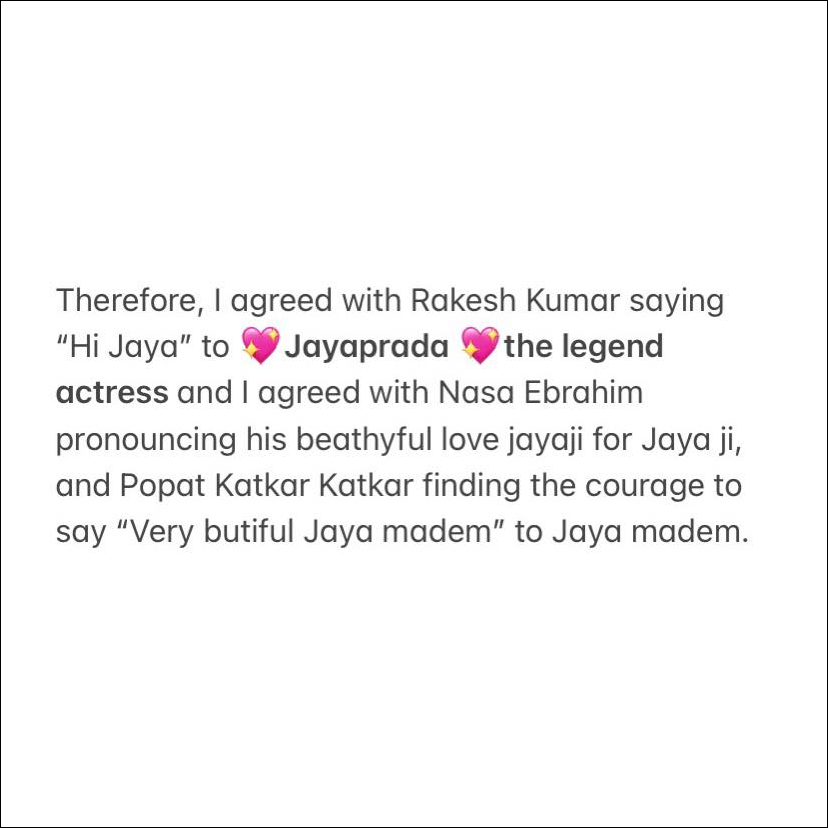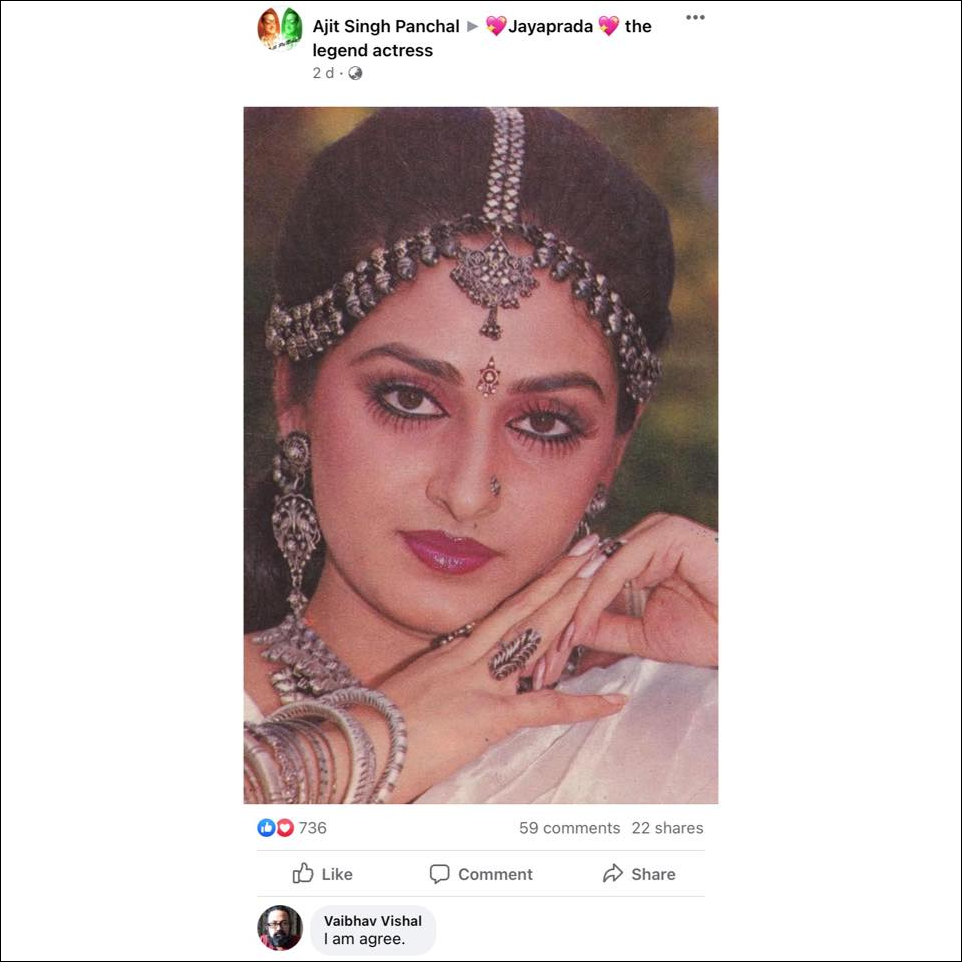Tagged: vaibhav
I’m leaving on a jet plane to Canada, and money is not an issue
I am a big fan of Justin Trudoeu Tredaeu Treduae Trudeau. I like Canada. I like Canadians. I also like Punjabi, the language most of the Canadians speak. So, naturally, I was intrigued when I got a mail with the subject “Canada Immigration” from one Suman Jha from Prime Track, an ISO 9001:2008 certified firm specialising in sending people to far out countries. Fairly articulate and persuasive, our man informed me that there was a shortage of skilled manpower in Canada, and the time was right for me to start the process of migrating to Canada without any delay. He also told me that he had profoundly reviewed my profile and that he was very pleased to inform me that my CV had successfully passed through what I am assuming must be their rather stringent first phase of screening process.
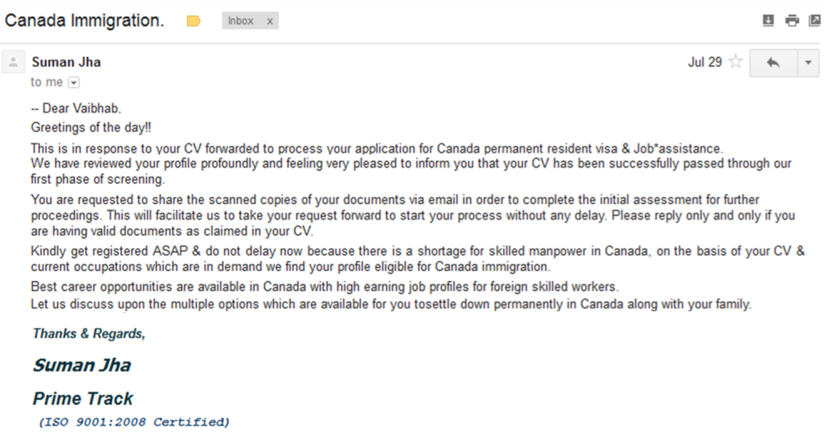
This was all fantastic. Only, there was one very minor technical issue. I had not sent him my CV.
So I did what any self respecting man secure with the belief that the best career opportunities were available in Canada with high earning job profiles for foreign skilled workers would do. I ignored his mail.
However, the eloquent Mr. Jha, with his dogged determination and stubborn seduction, would not have taken no for an answer. He sent a few more mails over the next four weeks, reminding me of the interest I had shown, asking me for the details of my documents, and promising me the completion of my documentation under the fast-track services. This was all too good to be true, this outpouring of concern and affection. Unfortunately, random unnecessary work took over my life, and I could not write back to him. Let’s just say the admiree was very much aware of the admirer’s strong overtures, but I had to consciously reject it.
Suman continued to have my best interests in his mind. The natural extension of his love was yet another mail from him.

“It;s a golden opportunity”, he said.
That one sentence did the trick. Guess I was hit somewhere deep inside – the semicolon hitting the colon, as they say – and that was enough to shake me out of my complacence. I was charmed and charged by the radiance of the golden opportunity, ready to immediately take on his offer. I was raring to go. And Canada was waiting.
I wrote a polite response explaining my silence and my readiness, in order. The mail also outlined some very regular practical issues I was facing. But I was sure it was nothing Mr. Jha or Prime Track, an ISO 9001:2008 certified firm, would not have been able to sort.
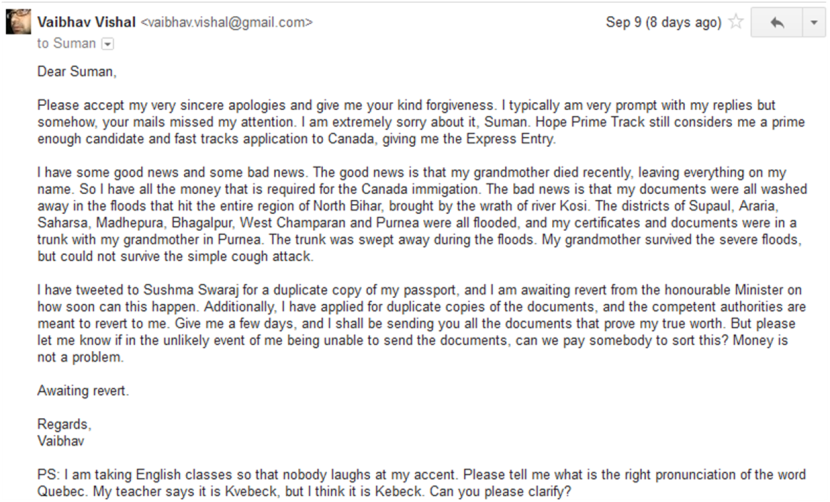
Surprisingly, my positivity was reciprocated by a very stoic silence. It was as if the fizz had gone from our relationship. It was my turn to follow up.

The professional Mr. Jha had a single-lined response for me. Apt. I deserved it.

He had not asked to me for write my biography. Obviously. I was blinded by the warmth that I had seen, and it had led to some weak moments. He was totally right in chiding me. This is exactly how businesses are conducted. I realised my mistake and apologised profusely to the man who stood between the Rocky Mountains and me.

Sassy Suman was back in the game. He sent me a quick reply asking me for my CV and other documents.

By now I had figured the curt Mr. Jha meant business. I sent my biodata to him almost immediately. I also had some basic queries for him to address. Felt stupid and sorry about sending those inane questions to him, thinking how smart guys like him have to go through such dumb Qs in their line of work. But then I thought Mr. Jha and Prime Track, an ISO 9001:2008 certified firm, must be used to such harmless naiveté of their clients.

He rejected my CV.
Crestfallen, I wrote a rather poignant mail to him. I was hurting. And it didn’t feel good. But despite the grief and the hurt, I maintained my poise and my positivity. I felt like a Himesh Reshammiya heroine. With a smile on my face and a song on my lips, I asked him to reconsider my application.
His response was the complete anti-thesis of the turmoil going in the atriums of my heart. He started using his silence to numb me, and comfortably so. I waited. Twenty-four hours later, I decided to graciously confront him while respecting his point of view.



I knew he would come around. I have lots of money. And come around he did.
THIS was the point where I figured a thing or two about the psychological make of Mr. Jha. He was a man of few words. That’s what he wanted in a man. He didn’t want long treatises. He wanted short jabs. I had to change my strategy to stay ahead in the game. I had to become as succinct as him.


The whole world stood in silence as the mano-a-mano struggle ensued between the two protagonists. And then he spoke. I had nothing but gratitude towards the big man.


Soon enough, I sent him all the documents that were needed. He had given me this extreme resolve to fight, live and survive. The underlying tension had led to this overarching tenacity. I was ready to take on the world!
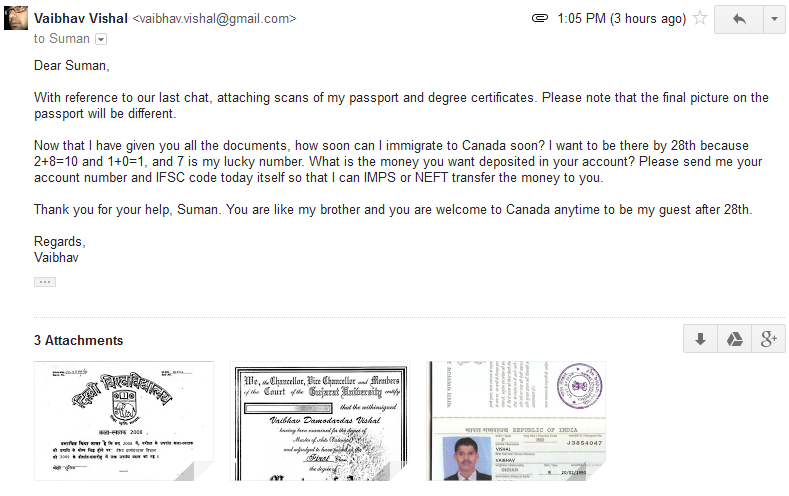
I knew what I was talking.

(And here are the scans of my passport and the BA degree. All legit, of course.)
It worked. We were now willing to go to the next level. We were exchanging numbers. And I am not just talking account numbers here.

This was not just a mail exchange I was having with the man. This was a life lesson I was learning. We were talking the talk. Kind of.

Just after I hit “send”, I realised that I had ended up sharing some very critical information about myself. And I knew it instantly that it would come back to harm and haunt me.
I had inadvertently revealed that there was somebody else in my life.
Mr. Jha decided we were done. He knew he had to severe all ties with me at one go. Just like that. Or not.

:|
He closed my file, but he opened my life. I am upset, yes, but at the same time, I am content that this experience made me find answers to that one question that has always bothered the mankind.
“Had i asked to you for write your biography?”
(If Close Encounters with Suman Jha is your kind of a thing, you may want to know more about my original heartbreaker, Probaldwip Bakshi.)
Revisiting JJWS – the OG Archies
1992 saw the release of Meera Ka Mohan, headlined by Avinash Wadhawan, featuring the chart-busting disco-devotional O Krishna You Are The Greatest Musician of the World. Keeping the cine-goers glued to the theatres also was Kumar Sanu crooning In The Morning By The Sea for Ronit Roy and friends in Jaan Tere Naam. The year witnessed SRK doing one of his earliest roles as a hero in Hema Malini’s directorial debut Dil Aashna Hai. Then there was Amrish Puri singing Shom Shom Shamo Sha while playing a trumpet, sitar and drums in Anil Sharma’s Tehelka. Govinda and David Dhawan found each other with Shola aur Shabnam, and Madhuri Dixit discovered her breasts with Dhak Dhak Karne Laga in Beta. For people with more discerning taste, Meenakshi Sheshadri referred to Chiranjeevi as Tota Mere Tota in Aaj Ka Gundaraj, Rahul Roy became a tiger in Junoon and Salman Khan wore a golden colored wig to pirouette with his inner Thor in Suryavanshi. Obviously, some of us had fun growing up.
1992 was also the year of Jo Jeeta Wohi Sikandar.
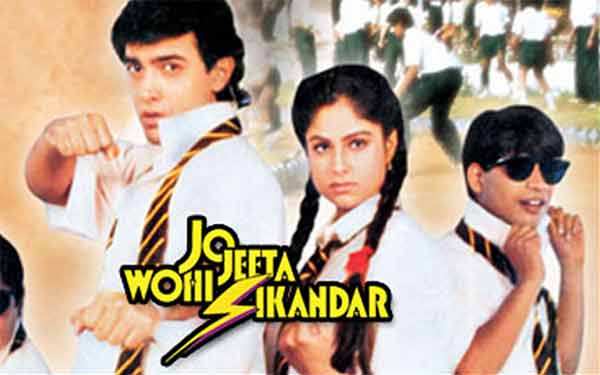
The brilliant Mansoor Khan’s second cinematic outing offered a straightforward story. Sanju is a happy-go-lucky boy, smoking cigarettes and bunking classes, leading a carefree life with his carefree friends in Dehradun. His father Ramlal is the sports teacher at the lowest-on-the-rung Model School. There is a clear class divide between the hill town’s elite schools and their local counterparts – nowhere more apparent than the bicycle race on which the movie hinges. When Ratan, Sanju’s elder brother, has a near-fatal accident while preparing for the inter-college race, it becomes Sanju’s responsibility to take over and compete against Shekhar Malhotra, the flashy champion from the flashy Rajput College. Sanju feels the combined agony of his father and brother, turns around, prepares for the race, wins it, and in the process, discovers himself. Jo Jeeta Wohi Sikandar. End of story.
But despite this very basic storyline, Jo Jeeta… is perhaps the only movie from 1992 to have survived the test of time 30 years since its release. If you happen to watch anything made that year, you will be taken to a world that is distant, jagged, and often embarrassing. The stencilled heroes waltz between the plastic and the profane, flaunting a rather coarse machismo challenging Mr Richter. The heroines wear conical bras, their Saroj-Khan-nominated cleavages heaving extra hard to seduce them heartless heroes and their ripped muscles. The villains are odd, outlandish, and over-the-top, and perhaps the most entertaining architectural remains of the era gone by. The films speak a language that is totally different from anything around or about us at present.
NOT Jo Jeeta Wohi Sikandar.
Tag it with the “Smoking is Injurious to Health” warning, cut Deepak Tijori’s hair short, ignore some of the fashion faux pas that are the vestiges of the horrible ’80s, and hell, it will pass off as the real deal even now! It remains as fresh and relevant today as it was then. The simple story, the key messaging and its aftereffects, the lovely everyday characters, the bonding and affiliations, the victories and defeats, the joys and sorrows, the aspirations and ambitions… all of it is universal and identifiable. Now, and perhaps even 30 years from today!
In the multi-layered backdrop of teenage yearnings, of silent, unrequited and failed romances, of the angst stemming from class divides between the haves and have-nots, Khan recreates the world of The Archies in an Indian avatar, sans any artificial pompoms and cheerleaders. Just a dash of Farah Khan and Jatin-Lalit freshness, the velvety voice of Udit Narayan, the vulnerability and innocence of Ayesha Jhulka, Aditya Lakhia and Deven Bhojani, and, of course, the charm of Aamir Khan as Sanju.
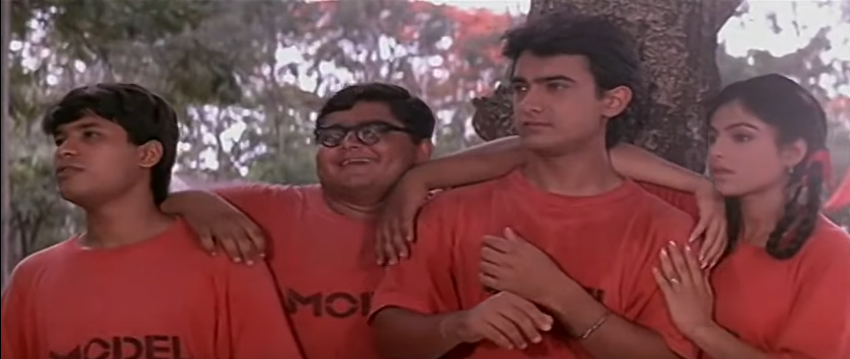
Sanju is vain, selfish, and twisted. He exploits Anjali, his best friend, because he knows she is secretly in love with him. He takes Maqsood and Ghanshu, his close confidantes and partners in crime, for granted while playing their ring leader. He consciously cons Devika – the shimmering, sizzling Pooja Bedi – into believing he is the son of the multi-millionaire Thapar. He actually instigates a fight at his father’s cafe and gets it totalled. Sanju is everything a hero should not be.
But there is something about Sanju that only heroes can be. He is a non-conformist. The defiant cry of Jo Sab Karte Hain Yaaron, Woh Kyon Hum Tum Karein is inspiring if you don’t subscribe to the thought, and comforting if you do. Your heart beats for Sanju because there is a little bit of him in all of us. Or there is a little bit of Sanju that all of us want to be. Precisely why you feel sorry for him when he gets exposed in front of Devika. Or when Thapar yells at him in the presence of all of his guests. Or when Ramlal throws him out of the house.
Ramlal is a strict father. He is also guilty of playing favourites. Which explains Sanju’s continued insubordination and insolence. The father is the system, the man. Sanju is the rebel, while Ratan follows the norm. To such an extent that when Sanju leads the pack in the Sheher Ki Pariyon Ke song, the elder brother voluntarily plays the second fiddle. The love between the siblings is not cardboard, melodramatic, or overtly emotional. And yet, when Ratan is admitted to the hospital, Rooth Ke Humse Kabhi tugs at your heartstrings and tears the ventricles out.
The rich-poor divide and the continuous hostility toward the poor – the pajama chhap – is a recurring theme in the film. Khan chooses a rather interesting cinematic device to reveal Sanju’s poverty to Devika. A dance sequence featuring a Chaplinesque Sanju, complete with tattered clothes. But you see the light at the end of the tunnel when you hear the Model School team mouthing the lines, Yeh Maana Abhi Hain Khaali Haath, Na Honge Sada Yahi Din Raat, Kabhi Toh Banegi Apni Baat, Arre Yaaron, Mere Pyaaron. It is almost poetic, Devika’s changing expressions as Sanju lives up his penury!
Jo Jeeta Wohi Sikandar appeared at a time when the reforms that would result in opening up our economy had just been initiated. We were still reeling from the garishness of the ’80s, but the theme of class inequality that populated the films of the ’70s still endured. Jo Jeeta… was perhaps the first film that brought home class inequality the way many of us actually experienced it. Not the way Amitabh Bachchan did, raging against the machine and the system. You weren’t fighting for scraps on the streets or refusing to pick coins off the road, but you did feel a twinge of jealousy when you saw someone in a nice car you couldn’t own.
For an entire generation of cine-goers figuring themselves in the 1990s, Jo Jeeta Wohi Sikandar was, therefore, not just a film. It inspired us to stay happy, take risks, not follow the norm, know and appreciate the value of success, and, well, work towards it. Jo Jeeta Wohi Sikandar was, in many ways, a lesson in life. And one realises this even more so now, looking back.
POST SCRIPT: 1992 was also the year a numerically sound Ajay Devgan checked on the audiences’ Jigar, Sunil Shetty made his debut in Balwan, Akshay Kumar started playing the Khiladi, and Sanjay Dutt figured the joys of romancing the wet sari in Yalgaar. We were one lucky lot, clearly! :)
The importance of being Bappi Lahiri
While Bappi Lahiri would continue to be celebrated for his very strong imprint on the musical legacy of India, his larger contribution in the social space remains as melodic and charming, if not more, with its own pronounced rhythm and bass. Because despite seemingly being a 1970s and 1980s music icon, Bappi Da inadvertently became the new India story for the generation that came into its own in the 1990s.
With the advent of Liberalisation and Globalisation, the changes that us 90s kids were witnessing were sudden and far too many, and my generation was scrambling for home grown icons that we could take pride in, and call our own. Somebody associated with beats of disco that were moving towards obsolescence already, some very brazen ctrl-c-ctrl-v accusations, and a pronounced regional accent in the Queen’s language perhaps was not what the doctor would have prescribed.
Only, in Bappi Lahiri, we did not just get an icon, but a superhero!
For this long haired short man flaunting the entire Kalyan Jewellers bridal collection, and then some, around his neck typified the spirit of the nation that we were to become, his capitalist-bull-in-a-socialist-china-shop personage breaking all the stereotypes that could have been. He embraced his obstinate confidence, he cradled his true blue rockstar credentials, he snuggled to his blings and glares, and in the process, he gave a big, big bear hug to us, to the India that was emerging. Highlighting that it was okay to believe in one’s supreme awesomeness, and that’s how any success story must begin. That we were no less than the others, that we were a strong, parallel force, complete with this luminescent luster that was both inside and outside of us, that even if we were questioned/ challenged/ ridiculed, we had reasons to be assured and optimistic, that we were ready to take on the world at our own terms.
Bappi Da’s public persona gave us the confidence to redefine cool, and create the idea of the lassi-in-a-can India that was blatant and unabashed and cheeky, ready to take off, and take on, and how! The man was Made in India much before aatmnirbhar became a part of our social lexicon. He gave us both coolth and comfort. And that’s essentially because he never tried too hard. The gold chains were naturally designed to be around him. The fancy sunglasses were mandatorily destined to cover his face. The self-comparison with some of the biggest international popstars was, therefore, the immediate and natural consequence. So what if he took inspirations ranging from Beethoven’s Fur Elise to UB40 to Modern Talking, he made them his own. He made them ours. This was him sticking it to the man, everything else be damned, and we loved it. The wheel, of course, turned a rather skewed full circle when he sued Dr. Dre for lifting one of his songs, Kaliyon Ka Chaman, and triumphed! We smiled. We chuckled. We laughed. We had arrived. We had won. The Kohinoor may still adorn the crown, we had managed our reparations.
Superhero. Bona fide superhero.
In my 10 years at MTV between 2000 and 2010, the decade that MTV was needed in India to shape and shake perceptions, Bappi Da and his personality consistently hovered around in our promos, shows, interstitials, powerpoints, the works. Hell, he literally hung out in all our acts and actions! But it wasn’t his musical presence that we are referring to. Newer sounds had emerged in both the mainstream Hindi film and Indipop spaces, and he did not really latch on to either. It was his radiant, care-a-damn presence, reflective, again, of the times we were living in. That assured rockstarness. The joie de vivre. He wasn’t willing to leave us. We weren’t willing to leave him.
I don’t think we would ever be willing to leave him.
Thank you for making us what we are, sir! Pyaar kabhi kam nahin karna.

The High Priest of the Lowbrow

Kader Khan wasn’t a writer or an actor.
Of course, IMDB credits him with some 110 titles as a writer, and 416 as an actor, and a career in Hindi films spanning four decades, starting from 1971. Op-ed pieces have reasons to sing paeans about his extremely prolific contribution to cinema, proudly propping up the impressive statistics of more than ten films a year on an average before or behind the cameras. His understanding of Hindi, Urdu, Hindustani and their apt everyday usage deservedly won him awards and accolades in equal measure. BUT. Kader Khan wasn’t a writer or an actor. Or just that.
Kader Khan was a concept. Kader Khan was a genre.
The 1980s were a decadent decade. Guess the sexy swag of the flower power was so very evolved and consuming and out-there, that it was kind of tough for the generation after to live up to its legacy. The existing icons were slipping, and the antithesis were getting deified. The spaces in Arts, Literature, Films and Fashion were being redefined, confusing the lows with the highs, and vice versa. Plastic defined the new aesthetics. Loud was the new doctrine. On the real world front, the bumbling buffoons of the Janata Party had mucked up the first non-Congress government and the bumbling buffoons of the country had decided to give Mrs. Gandhi a second chance. The angry young man was ceasing to be as angry. From the suave smugglers, the lalas and budmash bahus were making comebacks as the villains of peace. It was as if all the powers in the world had combined forces to put everything in the regressive mode. The pace had become slow. The bar had become low.
Enter Kader Khan. The high priest of the lowbrow.
Of his four professional decades, it was the 1980s that saw the Kader Khan phenomenon explode. He was involved in the story, screenplay and dialogues of more than seventy films between 1980 and 1989, and almost half of them were hits. From innumerous Jeetendra PT shows like Himmatwala, Justice Chaudhary, Haisiyat, Akalmand, Sarfarosh and Maqsad to the Anil Kapoor-Jackie Shroff bromances Andar Baahar and Karma, from Amitabh Bachchan megamovies like Lawaaris and Yaarana to family tearjerkers including Swarg Se Sundar and Bade Ghar Ki Beti featuring ungrateful sons and vicious daughters-in-law, to the exquisitely convoluted Khoon Bhari Maang featuring Rekha fighting a crocodile, Kader Khan helmed it all.
Here’s the thing, though. Kader Khan did not just create the 1980s cinema. He created the 1980s. He almost decided on the narrative for the decade. He established the world as he saw it. And the world became him. Where the hero could dance around matkas wearing atrocious wigs, sweaters and suits, taming the womenfolk who alternated between playing Thunder Thighs and Pyaar Ki Devi. Where Advocate Shobha and Meva Ram could co-exist with Naglingam Reddy, Desh Bahadur Gupta, Abdul Karim Kaliya and Pinto The Great Smuggler. It was a realm where he stuffed everything he could, and made it large.
The audiences lapped it up. They were indoctrinated already.

There was a method attached to the man’s mission, though. Kader Khan catered to the lowest common denominator without any apology. He was of the people, for the people, by the people, only, louder, shriller and definitely more piercing. The trick was to pick the right elements with the right connect from the world that surrounded him and enhance them manifold. That was the Kader Khan formula, if there was one.
His hero, therefore, was a potent and colorful mix of Chacha Chaudhary’s brains and Sabu’s brawn, complete with the native Amar Chitra Katha sanskaars, and a pair of dancing shoes. His character actors were garish, ear-splitting reflections of how he saw the real world. So the unscrupulous trader from Swarag Se Sundar (1986) isn’t just an unscrupulous trader. He is actually called Milavat Ram in case you miss his blatant beimaani, and his shop is called Do Aur Lo Karaane Waala, in case you still miss his blatant beimaani.

Kader Khan brought the lowbrow out of its cultural closet. Not only did he specialize in it, he basked in it. He genuinely loved the “ghun ki tarah gehun mein pisne waale gadhe” and did his darnedest to give them their place under the sun. His metaphors and similes were not to flaunt his linguistic wizardry. On the contrary, he browbeated them to such an extent that they ceased to be anything beyond this non-nuanced gimmickry of words. This democratization of upma and shlesh alankaars was poetic justice, so to say, for the masses. “Dosti ka thoda atta lete hain. Ussmein pyaar ka paani milaate hain. Phir goonth-te hain. Phir dil ke choolhe par rakh ke ussko pakaate hain.”, says Amitabh Bachchan in Yaarana (1981) while describing how he prepares rotis for his best friend Amjad Khan. Okay then.
He made moviemaking and movie-viewing a watered-down version of what they were, and he wasn’t sorry about it. Crass became mainstream, villains became comedians, comedians became circus clowns. When somebody points out to Mukri in Dharam Kanta (1982) how he is rather short to be a dacoit, he says, “Jab hum chhota daaka daalte hain toh hum chhote ho jaate hain, jab hum bada daaka daalte hain, hum bade ho jaate hain”. And then you sample this Kader Khan truism from Meri Aawaz Suno (1981): “Mera naam Topiwala hai. Maine bahut saare ghamandiyon ke sar kaat kar apne kadmon mein kuchle hain, aur unnki topiyon ko apne paas saja kar rakha hai.”, as you see Topiwala proudly displaying his prized scalps. You can’t get straighter than that now, can you?

The audience roared. Kader Khan worked. Full stop.
And Kader Khan continues to work. In Sambit Patra & Co. on news channels. In Bharat Mata Ki Jai Whatsapp forwards. In Tanishk Bagchi remixes. In The Kapil Sharma Show. In over the top characters and situations, dialogues laced with obtuse humor, vulgar misogyny, hahaha jokes and the dholak beats to highlight the punchlines. One may complain, get offended, feel repulsed, and rightly so. And then one may snigger when nobody’s watching. Because the lowbrow charm scores. Every single time.
“Mujhe swarg nahin jaana hai kyonki swarg jaane ke liye marna padta hai”, said Kader Khan in Ghar Sansar (1986) as Girdhari Lal.
Both Girdhari Lal and Kader Khan must be having a good laugh right now.

Ranting on rice, and then some

Of all the stupid things that the Indian humans can do to showcase their ‘talent’, writing on rice grains sits right at the slimy, slushy bottom of the universe, not very far from creating gulab jamun vadapavs, or getting 8-year olds to do pelvic thrusts on national TV because dance India, dance.
Unless your brain has been designed to sexualise Ajay Devgn’s gutka-painted teeth, how can you even think that writing microscopic letters on food grains can be a good idea! I mean, why. You have all the time and patience in the world. You can crack the nuclear codes. You can write your own philosophy. Hell, you can start your own cult.
But. No.
You take a grain of rice. You scribble something on it. You then realise it cannot be read by the naked eye. This is when you must stop. Instead, you get inspired to doodle some more. And then some more. Till you write the entire Bhagavad Gita on grains of rice. Grains that could have been rightfully converted into biryanis, dosas, kheers or phirnis, and justified their presence on the planet. Only, you decide to convert them into freakshows for Uncle Barnum’s circus. Painted with the kind of precision and perfection that can make great serial killers on a good day.
And your fellow countrymen offer milk to your Ganesha statue seeing those tiny mutated pebbles. The lines between crafts, arts and gimmicks blur till they become a huge blob of nothingness. The middle class almirahs filled with middle class aesthetics go ballistic showcasing these granular inanities. Along with milk art, paper carvings, drawing on sesame seeds, and ugly large dolls in their original packaging, of course.
Gulab jamun vadapav and a grand salute to you! Kya baat. Kya baat. Kya baat.
I am agree. I really am.
I got a job offer from BNP Paribas. What happened next would not shock you!
I rarely get mails which offer me jobs. In fact, I rarely get mails. Solitary reaper, et al. Which explains why I got so enamored and impacted by this mail forwarded to me by one Probaldwip Bakshi from SREI BNP Paribas, offering me a job as “Assistant Manager – ARM – Opportunity Management” at Durgapur. The mail was accompanied by the scanned copy of the offer letter and the renumeration package. For my perusal. (I didn’t really have to write the last sentence, but I don’t always get to use the word “perusal”, and I think I have a secret crush on the word. So yeah. For my perusal.) I was also told that the hard copy of the offer letter along with the joining kit would be handed over to me on the day I would join them.

Now, I have always had a fixation for joining kits. I rarely get joining kits. Plus, “Assistant Manager – ARM – Opportunity Management” sounded like my kind of thing. But most importantly, who can say no to working with Probaldwip Bakshi! Naturally, I lapped it all up, and sent a merry reply confirming my acceptance.
Mr. Bakshi, the OPM – SH (WB), sent me a short and curt reply, establishing the working relationship and expectations. That’s the kind of boss I have always wanted. Quick on the uptake and sort of British. Succinct and successful. I could only thank my gods for the good fortune. More so, because I rarely get replies.
 I sent an immediate mail back to Mr. Bakshi, offering him my undying support in this momentous journey we were about to take together. I also had a few routine questions and clarifications pertaining to the job.
I sent an immediate mail back to Mr. Bakshi, offering him my undying support in this momentous journey we were about to take together. I also had a few routine questions and clarifications pertaining to the job.

And just when I had started thinking how I would play Tonto to this amazing Lone Ranger, I got a note from Chandrima Dutta, asking me to stop all communication on this subject. Just like that. No, really!
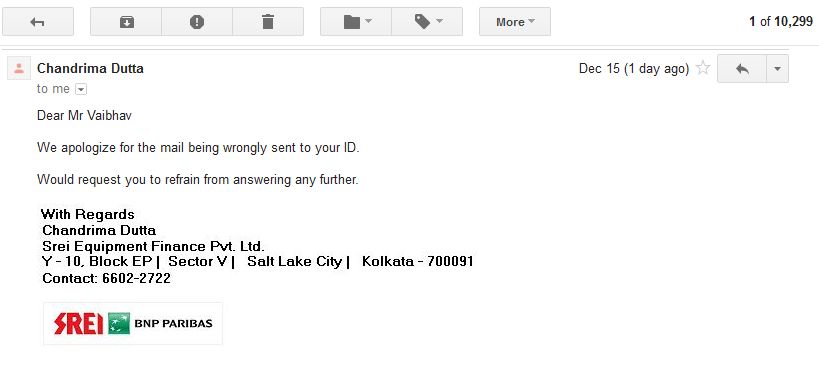 Crestfallen and dejected, I tried figuring this sudden change of behavior towards me. We were on a happy Paribas ride not very long time back, all of us, and now this! My innocent mind could not fathom why would something so bitter and brutal reach my inbox. And while I have always followed the peaceful path displayed by Dr. Martin Luther King, I could not control myself from questioning the logic behind Ms. Dutta’s mail.
Crestfallen and dejected, I tried figuring this sudden change of behavior towards me. We were on a happy Paribas ride not very long time back, all of us, and now this! My innocent mind could not fathom why would something so bitter and brutal reach my inbox. And while I have always followed the peaceful path displayed by Dr. Martin Luther King, I could not control myself from questioning the logic behind Ms. Dutta’s mail.
 Ah, Human Resource people, why art thee so cold, callous and cruel! Not only did Ms. Dutta decide to not write back to me and answer my good-natured, noble-intentioned questions, she also used her continued silence as her strongest weapon to shut me up and crush my child-like enthusiasm. This painful placidity, this sullen stoicism was too much to take for the very emotional me. My plan to make a difference to the world was savagely sabotaged by the world.
Ah, Human Resource people, why art thee so cold, callous and cruel! Not only did Ms. Dutta decide to not write back to me and answer my good-natured, noble-intentioned questions, she also used her continued silence as her strongest weapon to shut me up and crush my child-like enthusiasm. This painful placidity, this sullen stoicism was too much to take for the very emotional me. My plan to make a difference to the world was savagely sabotaged by the world.
I decided to not take up the job. :|

This hasn’t quite been the best experience of my life, but I still believe in the goodness of mankind. I believe in angels, something good in everything I see. I believe in quoting from an ABBA song and not giving them any credit for the same. I believe in honest people getting what they deserve, what is rightfully theirs.
Only, I rarely get mails which offer me jobs. :(
(I later gathered that the email ID of the guy they were trying to write to was vaibhav.vshl@****.com. Clearly, his favorite actor is Ajay Dvgn. His Action Jackson affiliations notwithstanding, I’m sure he makes a better candidate than me, and would do very well at the awesome organisation that SREI BNP Paribas is, blending in with the lovely people in there. All’s well that ends well.)
Pehle toh kabhi kabhi gham tha… And then came Altaf Raja
These are bad times.
The economy does not look all that great. The drought situation is getting worse. Politicians continue to stay aloof and unaffected. Cricketers are getting fixed. Fixers are running cricket. Business leaders are getting their CFOs pregnant. Jackie Bhagnani is still acting.
These are really bad times.
Now, I know there is this terrible terrible urge to hang our heads in despair and feel hopelessly bad about our existences. It does come naturally to most of us, especially after seeing those Rangrezz posters. But you know what, life is not that black, despite how bleak things appear. One can either feel utterly depressed. Or, one can invoke the name of Altaf Raja to make it all disappear. Seriously.

Altaf Raja who, do I hear? For those not in the know, Altaf Raja was the singular reason why the cassette players of the 1990s were mobbed, mauled and molested, day in and day out. Altaf Raja was the demi-god of the autodrivers, their secret man-crush, their muse. Altaf Raja was the snazzy sultan, the ritzy rajah that the entire B-grade population of India wanted to be. But to top it all, Altaf Raja was what kept the people across the country going, giving them hope and optimism, as they sung his songs in the trains, collecting monies for charity, in most cases their own charity.
The first half of the 90s was an exciting period in the life of India. The skies were opening up. The reforms were taking off. We were a bemused and overwhelmed nation, getting exposed to an MTV which played music and a Manmohan Singh who had a voice, amongst other things. The divide between the rich and the poor was beginning to get drastically wider. Rishi Kapoor was still wearing Woolmark-approved pure wool turtlenecks, dancing around trees, and Mithun Chakraborty was singing Gutar Gutar in Dalaal. Not that the last two statements had anything to do with each other.
It was during these times that Altaf Raja made an appearance in the Indian stratosphere. Tum toh thehre pardesi, saath kya nibhaoge, he said it on behalf of the country in his first album in 1996, mouthing the concern that the economic reforms were not to stay forever. Subah pehli gaadi se ghar ko laut jaaoge, that is.
But then again, lest you misunderstand him, it was just a healthy expression of anxiety, and not pessimism. Considering in that very album, Altaf presented the enthusiasm and exuberance of the nation, willing to take on the world: Woh bhi anjaan thi, main bhi anjaan tha. Uss se vaada na tha, kuch iraada na tha. Bas yun hi darr-ling keh diya. Yaaron maine panga le liya. Panga Le Liya summed it up brilliantly. Pokharan-II, the Indian nuclear tests happened soon thereafter.
And THIS – the eternal understanding of his environment and its impact – is what makes Altaf Raja relevant all over again in our lives. Yes, the times are tough. From pathetic rapes to pitiable rappers, from a silent PM to an over-zealous wannabe, from Kalmadi’s fistulas to Kejriwal’s frictions, we have issues and diversions. But we need to embrace our surroundings. And wait. Patiently. Because that is the right thing to do. Thoda intezaar ka mazaa leejiye, sang our man in Shapath. That’s the mantra to live by. Wait and watch, and enjoy the downtime. All material conditions, positive or negative, are temporary. This, too, shall pass. Btw, for the fans of geriatric gyrations, the song has Jackie Shroff and Mithun Chakraborty shaking it with the ladies at the bar. That, too, did pass.
His teachings, though, are not restricted to just helping people cope with the larger issues. Altaf Raja has created many a sparkling gem that are relevant to us in our everyday lives across audiences. Even more so in this day and age, when everything around us is getting redefined and restructured. Refer to the lucidity with which he discusses the complexities of the gender roles and the set of social and behavioral norms that are considered appropriate in the context of the modern times. Biwi hai cheez sajawat ki. Biwi se ghar ko sajaate hain. Sautan ka shauq purana hai. Sautan ko sar pe bithate hain. Bharti nahin niyat sautan se. Sautan ki sautan late hain. Balle balle, oh yaara balle balle. Wow Yeah. Wow Yeah. Brilliantly put. Sajawat. Aesthetics. This is why the purists love him.
The most pertinent message of Altaf Raja for his audiences, however, is in this timeless creation called Kar Lo Pyaar. There are discords and disputes all over. Conflicts have divided the globe. The world is fighting a furious war with itself. And I just used three sentences with exactly the same meaning. Precisely the reason why the world needs to hear these immortal lines in his mellifluous voice. Kar lo pyaar, kar lo pyaar, kar lo pyaar, kar lo pyaar. Pyaar gazab ki cheez hai padh lo aaj subah ka parcha. Pyaar karoge muft mein ho jaayega yaaron charcha. This is poetry at exceptionally sublime levels. No other song in the world has EVER tried rhyming charcha with parcha.
Wikipedia says Altaf Raja has had a mix of twenty-three film and non-film albums so far. But none of this matters eventually. Because it is not about his songs or the albums. It is about the man. Who goes far beyond the songs or the albums or the hits or the platinum discs. Altaf Raja is a concept. He is the victory of the mundane over the elite, of penury over pomp, of the coarse over cultivated, and of hopes over realities.
Thank you for taking the panga, sir!
(Originally published on firstpost.com)
Chhatth Puja and the GulshanKumarisation of India
My Bihari cousin is getting married to a lovely Tamilian girl.
I am sure the dainty Miss Sridhar must be doing her homework already to know more about what she is getting into. We may not have life sized cut-outs of Ms. Cloaked Rotundity and Mr. Goggled Baldness, but we have enough loud fodder loud enough to make her feel at home. What we lack in flashy flamboyance, we make up with our brassy brashness. We are a raucous country, yes ma’am. When the alphabets were getting distributed, the Biharis decided to take everything with all the hard consonants. Marathis come a close second. Pethe, Kekade and Madke would agree.
But let’s stay on Bihar. Or in Bihar, if I were to take Raj T’s advice.
So we have Litti, Laktho, Thekua, Ghughni, Bhabhri, Makuni, Khaja, Pedakiya, Gaja, Dalpittha as a smattering of names randomly taken from the Bihari fridge. NONE of them sound appetizing. Not one. They taste phenomenal, but they don’t sound like something you may want to consume. And some of them look like what they sound like.
Blame it on the pastoral background of the Biharis, if we were to get all historical and sleuthy. While the neighbourhood Bengal was busy carving intricate creases on their Nolen Gurer Sandesh, singing their Baul and doing their Dhunuchi Naach, Biharis were too busy either tilling their lands or rearing Chanakyas, Buddhas and Mahaveers. So they did not really have the time to create artworks in the kitchen or outside of it. We developed as an ungainly and unsophisticated nation, without any apology and with a definite hint of pride. Take it, world!
And this gets reflected in everything we do. Or say. Or make. Or celebrate.
Which brings me to Chhatth, a festival that some theorists claim even predates the Vedas. At the concept level, it has perhaps the most modern outlook for a festival so ancient. There is no idol worship at all in Chhatth, unlike most Hindu festivals. It is not gender or caste specific. And there is no involvement of a presiding pandit. No random mumbo jumbo being babbled by some patronizing priest working on an hourly remuneration in front of a gaudy concoction of gods. It is a festival with rituals led by the devotee, dedicated to the deity. A hardcore one-on-one with the all-encompassing to acknowledge and achieve the common, combined greater good.
Spread over four days, the worship is dedicated to the Sun god and his wife Usha, greeting and thanking them for creating and controlling all the life forms on the planet earth. While Chhatth follows Diwali, it is no selfish agrarian festival stemming from the contribution of sun to the agricultural produce, coinciding with the cultivation. It is a very noble recognition of the influence of sun in our combined lives, way beyond its material beneficence, with pronounced philosophical undertones. Which explains why the worship of the rising sun is preceded by the veneration of the setting sun.
So far, so good.
Only, I don’t remember getting influenced or enamoured by any of this while celebrating Chhatth in the Patna of the late 1980s. Neither by the philosophy behind the festival, nor by its rather liberal stance. Outside of the exhilarating thrill of traveling at 4 in the AM for the morning arghya, moving past the colourfully lit-up roads to a crowded Pehelwaan Ghaat or Collectorate Ghaat, and then letting the feet play with the cold, moist sand, what actually has stayed with me is the harsh aesthetics of it all.
I am not referring to the festival, of course.
I remember the crowd. A sea of humanity amidst all the muck of the riverfronts. People rushing at the ghaats with their chaadars, fighting for and marking their territories to be as near the slushy expanse of the Holi Ganga. The rich and the powerful moving around with their gun-toting musclemen. The blaring loudspeakers, the long traffic jams, the arguments on the roads, the hawkers selling posters of Hindu gods, including Arnold Schwarzenegger, and the general wide-ranging cacophony of the people forming a buzzing backdrop. It all came together into something memorably lurid and raw.
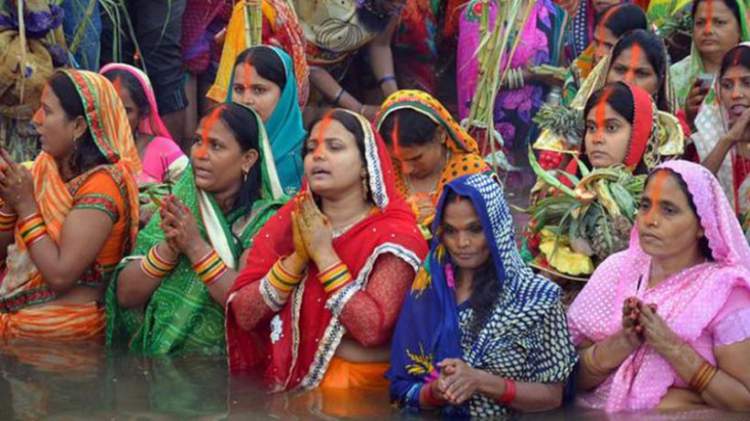
This rasping rhapsody was amplified by the sindoors on the noses of the parbaitins, or the fasting worshipping ladies. Indeed. A shining, flaming, thick and radiant saffron vermillion marking starting from the tip of the nose meandering into the parting of the hair. Imagine multitudes of ladies with their brightly painted noses half immersed in the muddy waters, offering their obeisance to the rising sun. The effect was mesmerizing. The effect was daunting.
To be fair, though, it was not just these nose antennas that were browbeating me into meek submission to all things colourful and coarse. The GulshanKumarization of India had just about started to happen. The combined might of jhankaar beats recorded in cheap Darya Ganj studios on Super Cassettes was beginning to juice the entire pantheon of Hindu gods and goddesses. Johnny ka Dil Tujhpe Aaya Julie was being appropriated as Bhakton Ka Dil Tujhpe Aaya Devi, and then some. People not only seemed okay with these, they were, in fact, revelling in them. It was a crude, uncouth phase in the life of India, both culturally and otherwise. Patal Bhairavi and Bhavani Junction were legit Hindi cinema releases, Rajeev Kapoor was playing the Lover Boy, Rajesh Khanna was romancing Reena Roy, and people were really paying to see Raj Babbar on the large screen.
It was the attack of the lowbrow. And Chhatth was as impacted as any other festival.
So in the middle of the folk songs evoking the Sun god, the shrieking loudspeakers would play one of them Karolbagh ditties sung by Babla and Kanchan. Hum Na Jaibe Sasur Ghar Re Baba. Yeah. Soon enough, these tardy renditions were accepted as a part of the mainstream. The eighties never left the festival. The festival never left the eighties. Every subsequent Chhatth was more of the same. Exciting. Rousing. Breath-taking. And very bloody loud.

I moved on. Bombay became home. Then I shifted to Mumbai.
Patna, Bihar and Chhatth continued to be a part of my subconscious persona, but not being there meant not being there. My new native city gave me newer references to ponder over. I had graduated from Gai Ghaat to Lal Bagh. I had moved on. Or so did I think. Untill I suddenly discovered the luminous vermillion-nose brigade in a traffic jam at Juhu one fine evening. The parbaitins were back in my life, and how! And I was amazed to see that twenty-five years later, the unhinged aesthetics and revelry were unaffected, give or take a few Sanjay Nirupams trying to make Chhatth the North India Pride Parade. It was beautiful. To be in that jam. To be back there. To relive the scale and the noise. And to revisit the fantastic reasons behind the celebration of this wonderful festival.
Here’s to many such discoveries, Sanjana! And welcome to the family. Some of your new relatives may look like aliens once every year, and their vocabulary may be predominated by words with ट, ठ, ड and ढ in them, but we are good, warm god-fearing people, I promise you. Despite that fluorescent patch on our noses. Or because of it. :)





